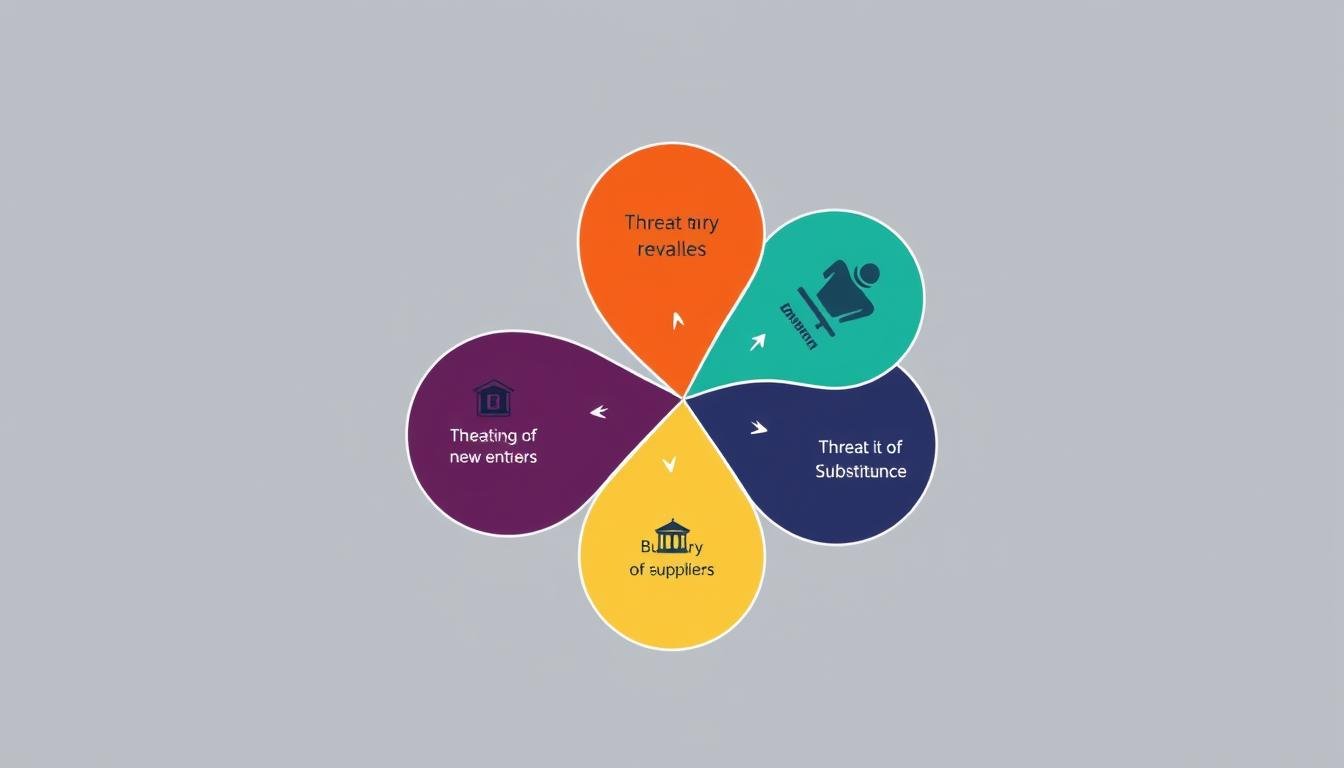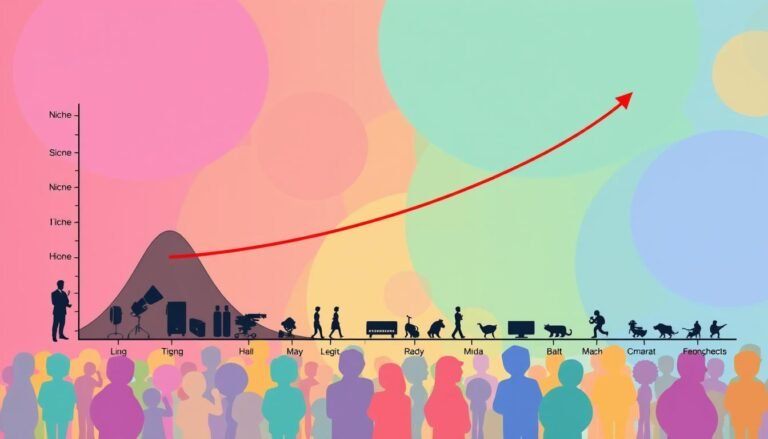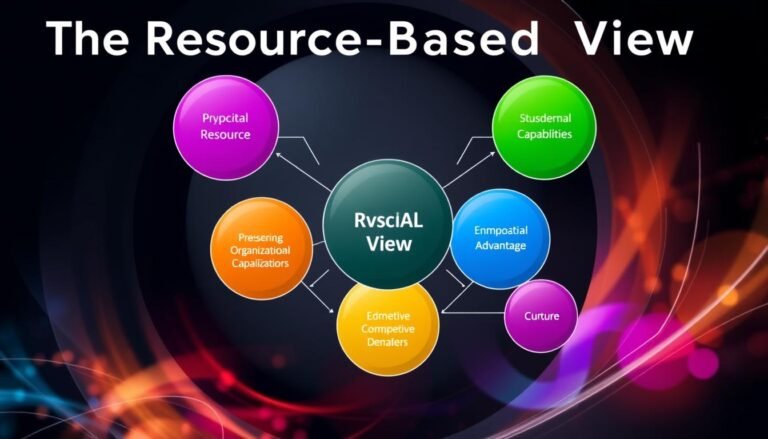Porter’s Five Forces: Analyzing Industry Competition
Ever wondered what makes competition in an industry so fierce? Is it just about how many companies are there, or is there more to it? Porter’s Five Forces can help us understand the deeper forces driving competition. This model, created by Michael E. Porter in 1979, shows us how five key factors shape the market.
These factors include competitive rivalry, the threat of new companies, and the power of suppliers and customers. They also cover the threat of products that could replace what we already have. Together, they help us see how profitable different sectors can be. This knowledge is key for making smart business decisions.
Key Takeaways
- Porter’s Five Forces include competitive rivalry, the threat of new entrants, supplier bargaining power, customer bargaining power, and the threat of substitute products.
- The intensity of competitive rivalry is determined by factors like the number of competitors and industry growth.
- Industries with lower barriers to entry generally see reduced profit margins for existing firms.
- Understanding the bargaining power of suppliers and buyers is critical for assessing industry profitability.
- Porter’s Five Forces support companies in strategic planning and positioning through detailed industry analysis.
Understanding the Origins of Porter’s Five Forces
The need to understand market competition led to the evolution of industry analysis. Traditional business models didn’t fully capture the complex nature of competition. This led to a search for a new framework, which resulted in Porter’s Five Forces.
Historical Context of Industry Analysis
Before Porter’s Five Forces, industry analysis was simple. Many businesses thought they were in perfectly competitive markets, ignoring the real competition. This led to poor strategic choices. Michael Porter changed this in 1979 with his article in the Harvard Business Review. He introduced a model that showed the different Competitive Forces at work.
Michael Porter’s Contribution to Strategic Management
Porter’s work changed Strategic Management by showing that competition comes from five main forces. These include new entrants, supplier power, buyer power, substitutes, and rival companies. Understanding these forces helps businesses navigate their industries better. Porter’s ideas help firms make smart strategic choices by understanding market dynamics.
| Competitive Force | Factors Influencing | Strategic Implications |
|---|---|---|
| Threat of New Entrants | Barriers to Entry, Economies of Scale, Brand Awareness | Can protect or intimidate existing firms |
| Bargaining Power of Suppliers | Supplier Alternatives, Cost of Switching | Affects pricing and profitability |
| Bargaining Power of Buyers | Buyer Concentration, Price Sensitivity | Shapes market positioning strategies |
| Threat of Substitute Products | Buyer Propensity, Product Differentiation | Can influence market share |
| Rivalry Among Existing Competitors | Number of Competitors, Market Growth Rate | Impacts profit margins and strategic focus |
Components of Porter’s Five Forces
The Five Forces Analysis is key for understanding the complex forces in various industries. It helps businesses spot both chances and threats that shape their strategies. This analysis is crucial for making smart decisions in a competitive market.
Comparative Analysis of Competitive Rivalry
Competitive rivalry is a big deal in the market. It’s shaped by several factors:
- Number of competitors in the market
- Growth rate of the industry
- Product differentiation among companies
- Existence of exit barriers
- Fixed costs associated with operations
High rivalry can cause price wars, hurting profits across the board.
The Threat of New Entrants in Various Industries
Porter’s Five Forces shows how barriers to entry help protect companies from new rivals. These barriers come from:
- Economies of scale
- Capital requirements
- Product differentiation
- Access to distribution channels
- Regulatory norms
Knowing these helps companies strengthen their market spot and keep new rivals out.
Understanding Supplier Bargaining Power
Supplier power is big in setting industry profits. For example, Volkswagen Group uses strong supplier networks to stay strong. This means they can get better prices and terms, giving them an edge over rivals.
The Power of Customers in Market Dynamics
Customers have a lot of say in the market, especially where there are many choices. Brands like Zara and H&M face strong pressure from shoppers. This forces them to keep coming up with new ways to keep customers coming back.
Evaluating the Threat of Substitute Products
Substitute products are a big challenge for companies, as they compete for customers’ attention. In the drink market, health drinks are becoming more popular, showing what consumers want. Knowing about this threat helps companies keep their products unique and profitable.
Understanding Porter’s Five Forces helps companies plan better. It shows the challenges and chances they face. This way, businesses can move forward with clear strategies.
| Component | Description | Impact on Industry |
|---|---|---|
| Competitive Rivalry | Intensity of competition within the industry | Price wars and reduced profitability |
| Threat of New Entrants | Barriers that prevent new firms from entering | Protects existing companies from market saturation |
| Supplier Power | Influence suppliers have on pricing and availability | Direct impact on production costs and margins |
| Buyer Power | Ability of consumers to dictate pricing and demand | Influences product offerings and marketing strategies |
| Threat of Substitutes | Availability of alternative products | Can erode customer base and revenues |
Porter’s Five Forces: Applications in Competitive Analysis
Learning how to use Porter’s Five Forces can really help with Competitive Analysis and Strategic Business Planning. This tool is key for businesses to understand market competition. It helps them see their strengths and weaknesses clearly.
Framework for Strategic Business Planning
Porter’s Five Forces is a big part of strategic planning. It helps firms look at the competition in their industry. The five forces are:
- The threat of new entrants
- Bargaining power of suppliers
- Bargaining power of buyers
- The threat of substitute products or services
- Intensity of competitive rivalry
This method gives deep insights that shape business decisions. For example, in the restaurant industry, companies face tough competition. They need to win over customers and keep their share of the market. They can do this with strong marketing and unique offers.
Case Studies of Porter’s Five Forces in Action
Looking at real examples shows how useful Porter’s Five Forces is:
| Industry | Key Insights | Competitive Response |
|---|---|---|
| Automotive | High barriers to entry due to established brand loyalty and capital costs. | Companies focus on enhancing brand equity and innovation. |
| Retail | Big-box retailers negotiate bulk discounts, impacting supply chains. | Consumer goods companies must optimize pricing strategies. |
| Digital Entertainment | High threat of substitution, with services like Netflix disrupting traditional media. | Content creators pivot to streaming models for distribution. |
| Education | Limited rivalry but continuous innovation driven by student demands. | Institutions invest in advanced curriculum designs. |
In each example, understanding these forces helps businesses make smart strategies. They can tackle competitive challenges and grab new chances. By using Porter’s Five Forces, companies can handle market changes, adapt to what customers want, and boost profits.
Critiques and Limitations of Porter’s Model
Porter’s Five Forces is a popular tool for understanding competition. Yet, it has its limits. Critics say it’s too static, not capturing the real-world’s complexity. This can be a problem for fast-paced industries where tech and customer tastes change quickly.
Companies should not rely only on this model. It might miss out on new chances and lead to bad strategies in changing markets.
Static Nature and Real-World Applicability
The Five Forces model often oversimplifies, missing the dynamic nature of competition. For example, high entry barriers can mean less competition, but economic or tech changes can change that. Companies with few suppliers might face pricing issues.
This shows that focusing equally on all five forces might not work. Some industries feel more impact from certain forces than others.
Considerations for Fast-Changing Markets
In today’s fast-paced markets, Porter’s model might not be enough. Globalization and tech make market lines blur. Companies across different sectors struggle to see who their competitors are.
Ignoring what customers want can make a business outdated. Focusing on customer needs helps companies stay relevant in a changing world.
| Critique | Description |
|---|---|
| Static Nature | The model’s static framework struggles to account for evolving competitive dynamics. |
| Industry Boundaries | Traditional definitions of industry boundaries may be ineffective due to market overlap. |
| Customer-Centric Focus | Neglecting customer needs can lead to strategic misalignment and loss of market position. |
| Technological Changes | Rapid technological advancements can render aspects of the model obsolete. |
| Non-Market Factors | Political, social, and environmental factors significantly impact competitive landscapes. |
Conclusion
Porter’s Five Forces model is key in understanding industry competition and strategic management. It helps companies see the competitive landscape. This lets them spot new chances and tackle current challenges in their market. For instance, with over 87,000 grocery stores in the UK, retailers face tough price battles.
Airlines show how low-cost carriers affect premium brands, making ticket prices drop and changing what customers expect. This change shows why it’s vital to know the forces that shape competition and profits. Companies like Amazon show how innovation can shake up old markets. Amazon sells over 95 million ebooks a year, changing the book industry and challenging traditional bookstores.
Some say the model is outdated, but its core ideas still offer deep insights into competition. Leaders can use these tools to tackle challenges from rivals, suppliers, and substitutes. This helps them stay strong in the market for the long run.
Source Links
- Porter’s Five Forces Explained and How to Use the Model
- Industry Analysis | Porter’s Five Forces | Competition
- Analyzing the Competition With Porter’s Five Forces
- The Five Forces – Institute For Strategy And Competitiveness
- Porter’s Five Forces: Definition & How To Use The Model
- Porter’s five forces analysis
- Porter’s Five Forces: Complete Guide, Examples & Template
- Porter’s Five Forces – MBA Crystal Ball
- Porter’s Five Forces: The Ultimate Competitive Strategy Blueprint
- Applying Porter’s Five Forces to Business Growth | Mailchimp
- The Pitfalls of Porter’s Five Forces
- Outdated Strategy: The Limitations of Porter’s Five Forces Today
- Porter’s Five Forces Analysis: Definition, Model & Examples Explained
- Master Porter’s 5-Forces analysis: a guide with template and example
- Porter’s Five Forces: Definition, Examples & Case Studies







